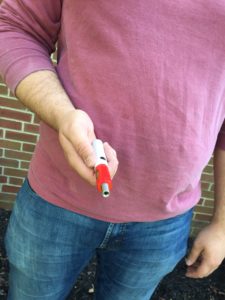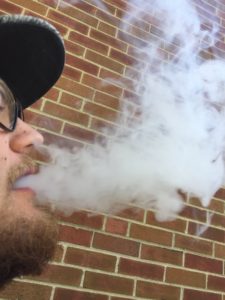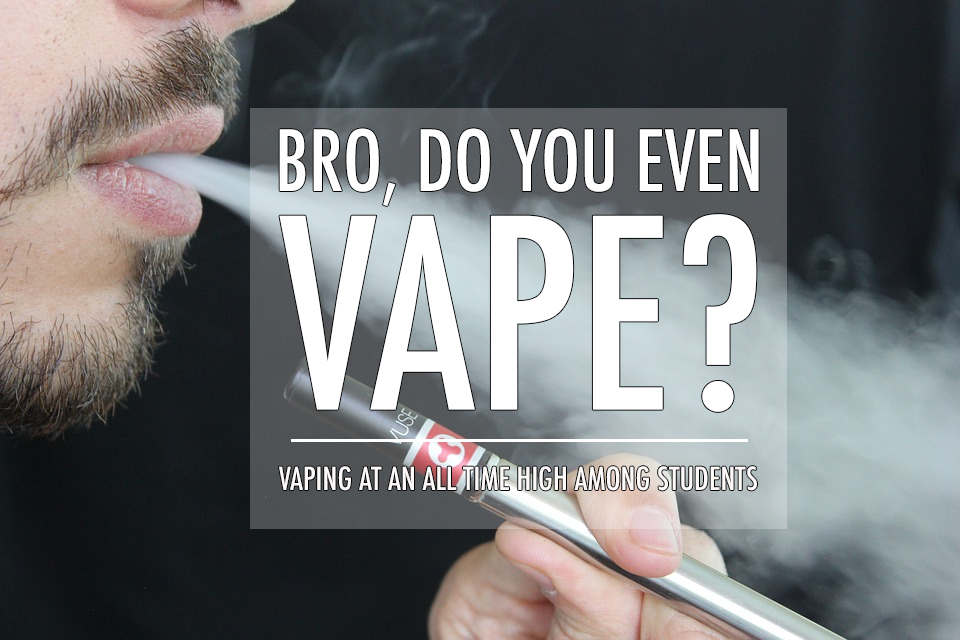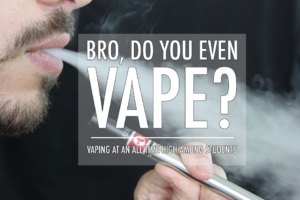Nationwide, students are more likely to vape now than ever with the rising popularity of tobacco alternatives such as the JUUL e-cigarette.
At one point or another, we have seen someone billowing out some dense white puffs at the fountains, or maybe we’ve been the victim of a sticky-sweet vape cloud while walking to class. This is becoming a more common experience on campus — and across the country — as more young adults take to vaping.
The Center on Addiction defines vaping as “the act of inhaling and exhaling the aerosol, often referred to as vapor, which is produced by an e-cigarette or similar device.”
After the first e-cigarettes were sold in 2004, there has been a dramatic increase in the number of people who choose to vape rather than smoke.
According to the Ohio Department of Health, e-cigarettes surpassed traditional cigarettes as the most popular tobacco product among youth and young adults in 2011.

The New York Times states that in 2016, over half of e-cigarette users were under the age of 35, with people between the ages of 18 and 24 being the most active consumers of the tobacco alternative.
One of the most popular brands of e-cigarette is the JUUL, currently the highest-selling e-cigarette on the American market.
According to the Centers for Disease Control and Prevention, “JUUL is a brand of e-cigarette that is shaped like a USB flash drive. Like other e-cigarettes, JUUL is a battery-powered device that heats a nicotine-containing liquid to produce an aerosol that is inhaled.”
Its discreet size and range of flavors are to be credited for its popularity with young adults, and have only added to the vaping trend.
Despite the increase in practice, the side effects of JUULing/vaping are not well known.
“I hear it’s preferable to smoking, which would make sense because of the tar and such, but I don’t really know,” AJ Beran, junior philosophy and political science double major, said.
The CDC states that it is difficult for consumers to truly know what is inside their e-cigarette products, but substances that users can potentially inhale while vaping include nicotine, diacetyl (a chemical associated with lung disease), several chemicals linked to cancer, unstable organic compounds, and heavy metals including lead, tin, and nickel.
Professor Hoag, a nursing instructor at Capital, said in an email that while vaping is commonly viewed as a healthier alternative to smoking or illegal drugs, it still poses a health risk.
“We know that nicotine is highly addictive and has effects on the developing brain – and there’s a lot that is unknown about the effects of inhaling chemicals and metal particles while vaping,” said Hoag. “You’re an adult now and can make decisions for yourself – but it’s important to think about it before you start a behavior that is likely to become a habit for you.”
Capital students are also advised to be mindful of where they choose to vape.
“Vaping is not permitted in campus buildings because it is not permitted under Bexley law which was updated in 2015 to included electronic and all smoking devices. All residential facilities are smoke and tobacco free,” Jennie Smith, dean of students, said in an email.

“Smoking within residential facilities is prohibited at all times without exception; this includes e-cigarettes, electronic nicotine delivery systems (ENDS), and all other devices associated with ‘vaping.’ Smokers are required to smoke outside at the designated smoking area. Outdoor smoking is permitted 20 feet from all residential facilities,” Smith said.
Failure to comply with these policies will mean meeting with a conduct officer to talk about the violation and determine a sanction to address the issue.
“Our sanctions are educational in nature, and sanctions may include referrals to campus and/or community services regarding smoking cessation for those who indicate a need,” Smith said.


